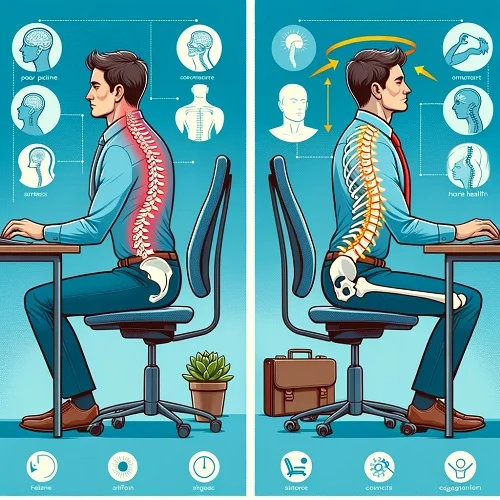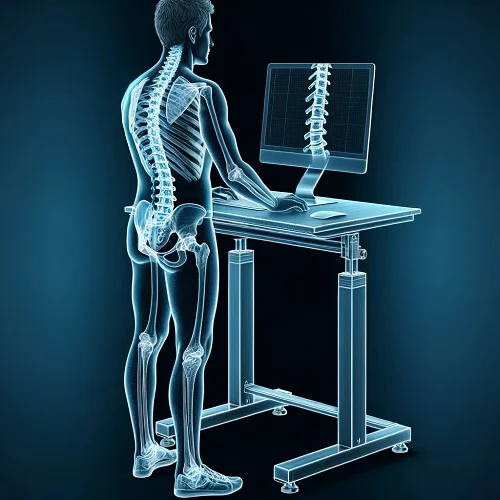As a chiropractor who has seen patients in 6 different countries, including the USA, it’s clear to me that Singapore is a world leader in workplace ergonomics and overall health and corporate wellness.
Singaporeans are much more progressive and proactive with their health than many of their first-world counterparts. What also sets Singapore apart is not just the implementation of ergonomic principles in workplace design but also the innovative mindset of its people.

The Problem of Microtrauma in the Workplace
Before we continue, let’s answer this question – What is microtrauma? Microtrauma refers to small, often unnoticed injuries to the tissues in your body, particularly muscles, tendons, and joints, caused by their repetitive overuse or stress.
These minor injuries can accumulate over time, potentially leading to chronic pain and other long-term health issues. Microtrauma is commonly seen in workplace settings due to repetitive motions and poor ergonomics, as well as in athletes and individuals engaged in regular physical activities.
In a workplace environment such as an office, it can be the result of a sustained posture and inadequate ergonomic setups. For example, continuous typing and mouse usage, coupled with prolonged sitting, can exert undue stress on the wrists, back, and neck, leading to microtrauma.
The Consequences of Microtrauma
The impact of microtrauma on the body can be subtle and cumulative at the same time. Initially, they can go unnoticed, masked by the body’s ability to adapt and compensate. However, over time, the accumulation of these small damages can lead to more significant health issues.
The spine, as the central structure in our body, is particularly vulnerable. Repetitive stress can lead to spinal misalignments, reduced mobility, and chronic pain. It also accelerates the natural degenerative process of the spine, leading to conditions like degenerative disc disease and osteoarthritis.
Comparison With Other Countries
In my years of practice across various countries, I have observed a general trend toward an increase in work-related micro-trauma cases, with the situation in Singapore particularly noteworthy. The fast-paced corporate culture and high technology usage intensify the risk of injuries like text neck, scoliosis, and more.
However, Singapore’s advanced approach to addressing these issues is commendable. There is a higher level of awareness and a more proactive approach to lowering these risks, which is evident in both the design of workspaces and the lifestyle choices of the workforce.

Health Concerns of Prolonged Computer Use
The digital age has dramatically shifted our workplaces, and computers have become an indispensable part of our daily and professional lives. However, with this shift came new health concerns, particularly for those who spend 8-10 hours a day in front of a computer. The sedentary nature of computer-based jobs, combined with the repetitive nature of many computer tasks, creates a perfect environment for the following:
- Digital eye strain, caused by extended screen time, is characterized by dry eyes, irritation, blurred vision, and headaches. Over time, this can contribute to more serious vision problems.
- Poor posture while using a computer, especially for long periods, often leads to back and neck pain. This happens due to the unnatural alignment of the spine and the strain on the neck muscles from leaning forward or looking down at the screen.
- Repetitive motions, such as typing and mouse use, can lead to conditions like carpal tunnel syndrome, tendonitis, and other RSIs (repetitive strain injuries).
- Sitting for prolonged periods can significantly reduce circulation, particularly in the lower extremities, leading to swelling, numbness, and an increased risk of blood clots.
Mental Health Considerations
Prolonged computer use significantly impacts mental well-being. Continuous work without adequate breaks can escalate stress levels, especially in today’s always-connected work culture.
Additionally, the overlap of work and personal life, especially in remote work scenarios, often leads to burnout, which is characterized by extreme fatigue and reduced work performance. These issues point to the importance of keeping a good work-life balance and the priority of maintaining good mental health at the workplace.
Long-Term Risks of Computer Use
If we overlook and keep ignoring the immediate health effects of prolonged computer use, it can result in serious long-term risks. Continuous back and neck strain may develop into chronic pain conditions.
Persistent eye strain could lead to lasting vision problems. Mentally, extended stress and burnout may evolve into anxiety, depression, and other disorders. Additionally, a sedentary lifestyle increases the risk of cardiovascular diseases due to poor circulation.

Solutions to Poor Office Ergonomics
Improving office ergonomics starts with ergonomic workstations. Standing desks allow flexibility between sitting and standing, and they reduce risks associated with prolonged sitting. Additionally, ergonomic chairs support proper spine alignment, while well-designed keyboard and mouse setups prevent wrist and arm strain and carpal tunnel. These changes not only increase comfort but also boost productivity and health.
Workplace Policies
Effective workplace policies can enhance office ergonomics a great deal. This can be done by encouraging regular breaks, which help employees relieve physical and mental fatigue. Flexible and tailored work arrangements are also important because they can alleviate the stress of traditional office settings, which brings a healthier work environment.
Employee Education
To promote a healthier work environment, it’s also very important to educate employees on proper posture and ergonomics. You can offer training sessions on how to adjust office equipment and maintain good posture.
These training sessions can, in turn, prevent many work-related health issues. Regular internal communications with tips and reminders further reinforce these healthy practices, which leads to a more informed and health-conscious workforce.

The Role of Chiropractic Care in Singapore’s Corporate Wellness
Chiropractic care plays an important role in addressing the effects of microtrauma because chiropractors use specialized techniques to realign the spine and alleviate pressure on affected joints and tissues.
This realignment helps when treating the root causes of pain and discomfort caused by microtrauma. If you browse the Internet for a “chiropractor near me,” you will quickly be in the hands of a professional who can aid in reducing inflammation, improving mobility, and helping your body in its natural healing process.
Preventive Measures for Workplace-Related Microtraumas
As a chiropractor, I have seen firsthand what regular chiropractic adjustments can do when it comes to preventing and treating pain from all-day sitting, mouse and keyboard use, or physical strains of some workplaces in Singapore.
In my practice, I like to focus on ensuring the spine and neck are properly aligned. This is crucial for lowering the risks associated with prolonged and repetitive motions that get harder on the body with the passing of time.
Maintaining optimal spinal alignment and alleviating neck pain will help patients significantly reduce the likelihood of developing chronic issues and other complications caused by their work habits.
Holistic Approach to Chiropractic Care in Singapore
Chiropractic care is holistic, and it focuses on overall wellness rather than just the temporary relief of current symptoms. A professional chiropractor assesses the entire musculoskeletal system and lifestyle factors to provide thorough care. This approach may include:
- Advice on posture, walking, sleeping,
- Ergonomic instructions,
- Exercises to do in free time,
- Nutritional advice.
All this contributes to overall health and well-being. Such a holistic perspective is integral to chiropractic philosophy, and it emphasizes the body’s ability to heal and maintain itself with proper care and occasional realignment.

A Chiropractor’s Perspective on Corporate Wellness in Singapore
My experience as a chiropractor who worked in many different settings has given me a broad perspective on the state of Singapore’s workplace health. As I stated before, it’s evident to me that Singapore leads the way in workplace ergonomics and corporate wellness. It’s mostly because of the proactive approach to healthcare and taking care of arising problems on time.
The approach here is not just about implementing ergonomic workplace designs but also fostering a culture of timely health management. Many locals in Singapore will often visit a chiropractor clinic near them to treat the issues on time when they still haven’t turned to chronic conditions.
Part of the success is owed to the still-honored traditional Chinese medicine teachings, and chiropractic care is definitely bridging the gap between traditional and modern treatments.
It’s settled – regular chiropractic care plays a vital role in both treating and preventing common workplace-related micro and macro traumas and related issues. If you need holistic solutions to problems caused by your workplace, contact us to quickly ensure your optimal health and productivity.

